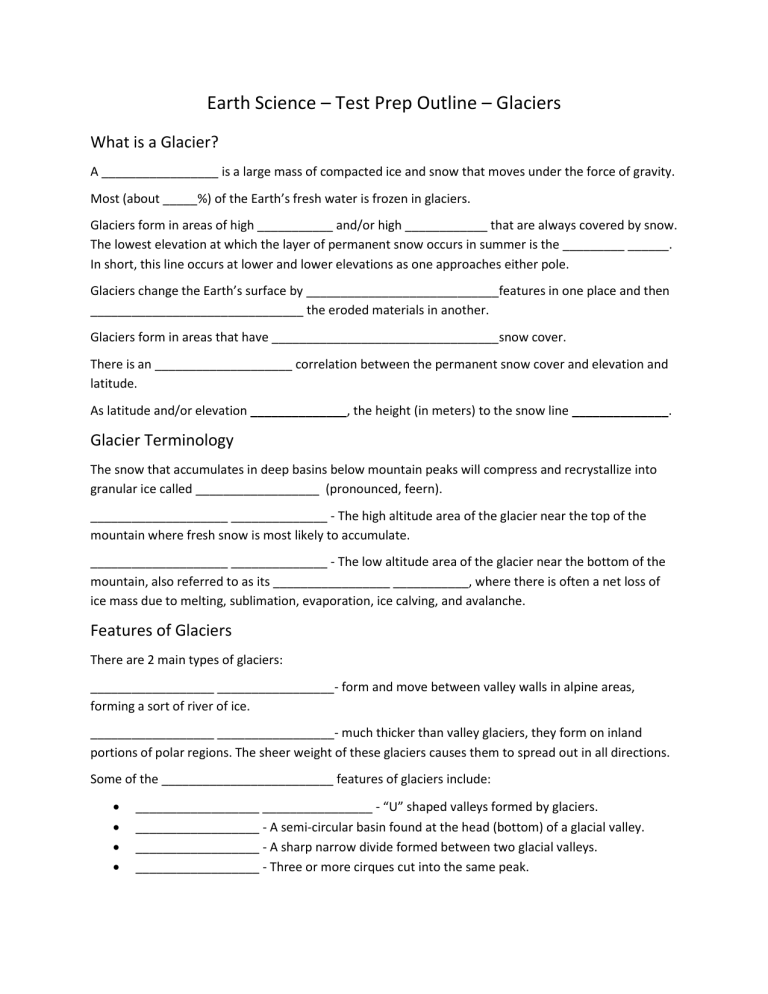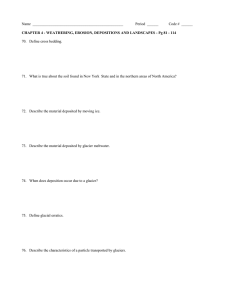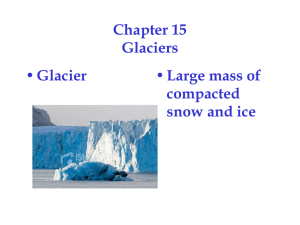Earth Science - Test Prep Outline - Glaciers - Blanks
advertisement

Earth Science – Test Prep Outline – Glaciers What is a Glacier? A _________________ is a large mass of compacted ice and snow that moves under the force of gravity. Most (about _____%) of the Earth’s fresh water is frozen in glaciers. Glaciers form in areas of high ___________ and/or high ____________ that are always covered by snow. The lowest elevation at which the layer of permanent snow occurs in summer is the _________ ______. In short, this line occurs at lower and lower elevations as one approaches either pole. Glaciers change the Earth’s surface by ____________________________features in one place and then _______________________________ the eroded materials in another. Glaciers form in areas that have _________________________________snow cover. There is an ____________________ correlation between the permanent snow cover and elevation and latitude. As latitude and/or elevation ______________, the height (in meters) to the snow line ______________. Glacier Terminology The snow that accumulates in deep basins below mountain peaks will compress and recrystallize into granular ice called __________________ (pronounced, feern). ____________________ ______________ - The high altitude area of the glacier near the top of the mountain where fresh snow is most likely to accumulate. ____________________ ______________ - The low altitude area of the glacier near the bottom of the mountain, also referred to as its _________________ ___________, where there is often a net loss of ice mass due to melting, sublimation, evaporation, ice calving, and avalanche. Features of Glaciers There are 2 main types of glaciers: __________________ _________________- form and move between valley walls in alpine areas, forming a sort of river of ice. __________________ _________________- much thicker than valley glaciers, they form on inland portions of polar regions. The sheer weight of these glaciers causes them to spread out in all directions. Some of the _________________________ features of glaciers include: __________________ ________________ - “U” shaped valleys formed by glaciers. __________________ - A semi-circular basin found at the head (bottom) of a glacial valley. __________________ - A sharp narrow divide formed between two glacial valleys. __________________ - Three or more cirques cut into the same peak. Glacier Movement Glaciers can move from a few centimeters to several meters per day. Glaciers move more rapidly at their ___________ and ____________. This is due to the _____________ forces of the valley floor and sides. _____________ _____________ - refers to glacier movement over the semi-frozen or slushy layer beneath the glacier, on which it slides. _____________ _____________ - refers to glacier movement caused by a deformation of the ice grains (due to pressure), which causes them to change shape and slide past each other. When glaciers reach the sea they can break off in a process known as ____________________________, thus creating _________________________. Glacial Erosion, Deposition, and Topographic Formations Glaciers are powerful agents of erosion. They can erode and transport materials that range from a fine powder to house-sized boulders. This material, known as _____________________, can ride on top of the glacier, be incorporated within the ice or be dragged under the glacier. ______________________ is the unsorted, unstratified rock material that is deposited by a retreating or melting glacier. The accumulation of till is called a moraine. The moving glacier will sometimes drag material over bedrock causing the bedrock to be polished or scratched (depending on the size of the embedded material). The long parallel scratches left by glaciers are called _______________________________. Striations indicate the glacier’s direction of movement. In addition to till, glacial ___________________ include: _______________ - sorted and stratified materials deposited by glacial meltwater. This meltwater often results in streams and lakes. _______________ ___________________ - the accumulation of till that is found at the end of a glacier’s farthest advance. _______________ - Large boulders that are transported by glaciers. Their composition is different than the surrounding bedrock. _______________ - Long teardrop shaped hills that point in the direction of original glacial movement. _______________ - Long winding ridges that form in tunnels in subglacial (below the glacier) streams. _______________ ____________ - Bowl shaped hollows found in moraines that are filled with water. (ex. Lake Ronkonkoma on Long Island) ________ ________ are periods of extended glaciation. The ice age started about two million years ago and ended about 11,000 years ago. The ice sheets reached their greatest size about 20,000 years ago when Long Island formed. What are some of the causes of ice ages?






